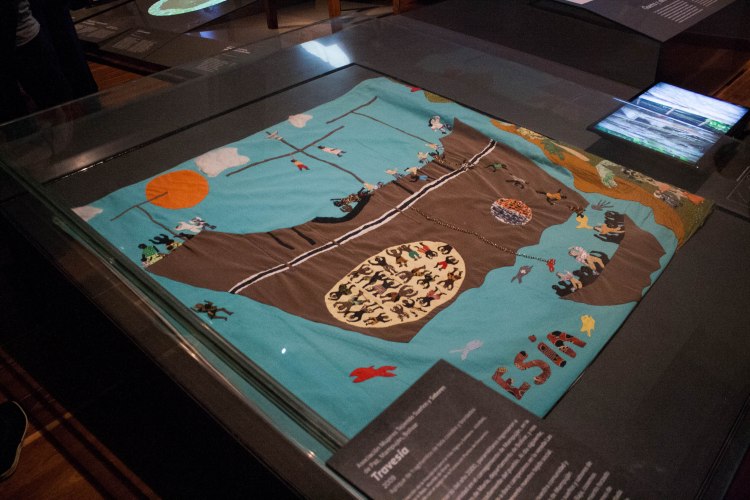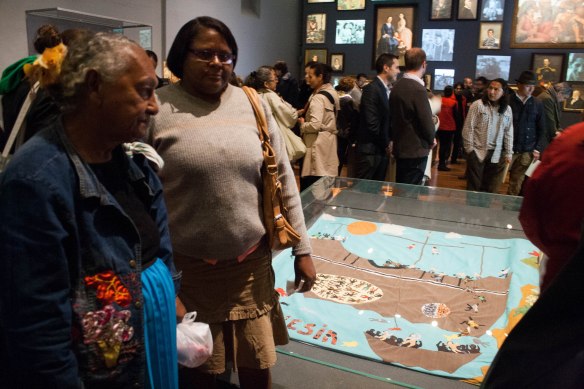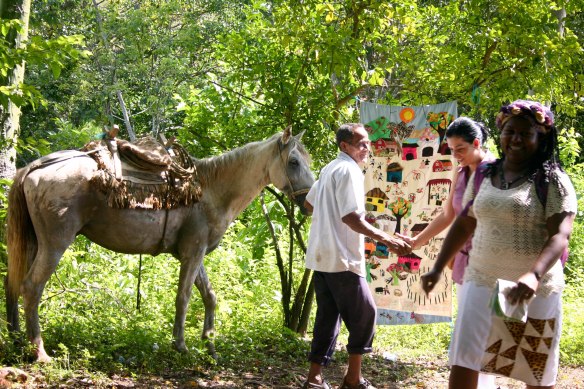By Anna Vogt, a service worker in MCC Colombia currently working with Justapaz, a Mennonite organization working for justice, peace and non-violent action in Colombia. Originally posted at: thellamadiaries.wordpress.com
I arrived at the National Museum first on Wednesday night and was afraid that I wouldn’t spot them, but there was really no need to worry. The moment they walked through the doors of the auditorium, I knew it was them. In fact, I would know the Mampujaneros anywhere: their energy, their charisma, their style, their exuberant greetings. And with one hug, it was just like old times. I took pictures of people taking their pictures, Juana bossed me around, Carmen asked me why I wasn’t married yet, Gladys laughed and Alex was chivalrous and charming, just like always.
Everyone was bursting with pride to see one of their quilts under glass in the newest permanent exhibit at the National Museum: Memory and Nation. As people congratulated, interviewed and snapped pictures, I was also bursting with pride because I knew all of them: where they lived, the names of their children, their favourite telenovelas, their family dynamics, but more than anything, pride that not only did I recognize then, I had experienced part of their history with them.
I came to Mampujan excited to work with the women’s quilting project and the possibilities of documenting oral history with a needle and thread. We had one meeting my first year and about five more my second, mainly because people from a government agency arrived to “assist” the project. It just was not possible, however, because of everything that was taking place in the community: meetings,marches, reparations, building projects, and a few moments for just plain life.
It was hard for me to accept that active quilting was simply not part of what the community needed at the moment. Instead, I found myself photocopying documents, advising on bank accounts, surveying, taking attendance, celebrating new houses with tiny cups of coffee, eating multiple ice creams a day and simply living out history with the community, all while feeling like I had somehow failed.
When I look back, however, the quilts were everywhere. At important meetings and events, they were the first things displayed in a place of pride. I become an expert at finding the bag of quilts in the depths of Juana’s home and hanging them up with tiny bits of twine and then taking them down after all the important visitors had left.
After about a year and a half of my time in Mampujan, the ASVIDAS (the productive organization that the quilting project is part of) leadership discovered that they owed a ridiculous amount of money in back taxes. One idea tossed around as a fundraising strategy was that every member, man or woman, would be responsible for making a quilt and selling it. Nobody actually made anything, but the space filled with immediate excitement.
Community leader Gabriel was quick to describe his future masterpiece. His quilt would focus on the peace dialogues and would include the negotiating group, along with members of the community marching and interacting with key political figures. The quilt as a whole would show the power of communities to create change from the bottom up. It didn’t matter that Gabriel had never sewn a stitch in his life or had no idea how to thread a needle: he was going to create change using fabric and determination because that is what they do in Mampujan.

The quilt in the museum is called Travesia (Travesty). In it, the women tell the story of their ancestors’ journey from Africa to Colombia, in the hold of a slave ship. It is a piece that describes their Colombian origins and also represents their contribution, even as slaves, to the country’s development from the very beginning. A video accompanies the quilt and positions the community and its history as a living reality by depicting the women sewing while narrating their current situation.
The quilt, its creation, and even the journey from Africa as slaves, are not simply static facts of a long past history. With each stitch and each piece of cloth, the women, and the community as a whole, recreate who they are and what they uniquely contribute to Colombia. It is through the national recognition and integration of these different histories that peace becomes possible.
At one point during the museum gala, a film crew asked attendees to describe what the new exhibition meant to them, in one word. When I asked Alex what his was, he went over the limit by telling me how moved he was to see his history on display. Among the stories of great battles and the deeds of dead white men, there was a room filled with not only a quilt of Mampujan, but also Indigenous artwork, gathering all of them into the idea of Colombia. For Alex, it was the first time he had seen “official history” in a way that recognized the story of his community and placed in on equal importance with the textbook histories of the white, rich, Bogotanos filling the room.
I still don’t have a Mampujan quilt of my own; in an unfortunate series of a events, a rat died and rotted on top of the one I was trying to make. It almost seems fitting in a frustrating way: I never sat with the women as they sewed, despite all of my longing. On the other hand, Mampujan taught me that histories are not simply a past to hang on the wall or write a book about; rather, they are actively alive in the present.
At one point during my stay, I was in a motorcycle accident and received 11 stitches on my left knee. Throughout my recovery, everyone in the community popped by to tell me their own accident stories and feed me cold oatmeal. Through this, and everything else we did together, I got to know people and their experiences in a far different way than I would have by trying to control a sewing circle. Sometimes, I like to think of my scar as a tiny quilt that tells the story of my time in Mampujan and as a reminder that the history I had the privilege of accompanying both belongs in a place of recognition in a museum, and can never be fully contained under glass because we carry it with us, wherever we go.
(I still want a quilt, however).






